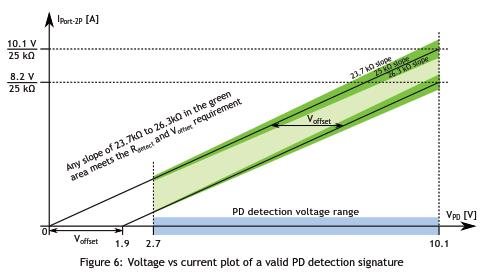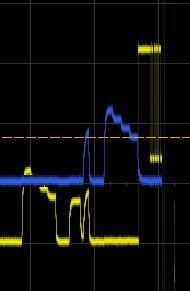Other Parts Discussed in Thread: TPS2373, TPS2372,
- 1. There is a stage called “Inrush” before PoE startup. According to IEEE802.3bt spec and your TPS2372/2373 spec, there would be limited inrush current for each classes such as 800mA to 900mA for Class 7 and 8. I measured the V-I curve of the TPS2373-4EVM-758 and measured the inrush current around 330mA which is meet the description of TPS2373 spec below. I would like to know why the TPS2373 spec describes the 335-mA inrush current is compatible with all PSE Types, it supposed in the range 800mA~900mA according to the 802.3bt standard, isn’t it?
2. A valid detection signature is to get a 25kohm for Rdetect, which I guess is calculated by the Ohm’s Law via measured V-I curve. It should take few points of measured V-I curve to get Rdetect, the valid detection signature is defined by the Rdetect is in the Range of R-slope as below photograph. I don’t know if I am misunderstanding about the detection method, please advise.
3.Here is the measured V-I waveform on TPS2373-4EVM-758. The Blue one is Voltage of Alternative A, the Yellow one is Voltage of Alternative B and the Green one is the current of I-port. As you can see, this is a whole procedure to powering a Class 8 PD with the CC_DET_SEQ constant as 1, it contains Detection/Connection Check/Classification/Inrush/Startup.
Continuing for the question2, the detection signature is given by Rdetect, which is Vdetect/Idetect, it is hard to judge how the PSE determine it is connected to valid PD by this photograph since current of detection is really quite small, the range of Idetect is around 102uA to 426uA theoretically, and the smallest current scale is 10mA for our current scope, so it barely can’t use this scope to get correct Idetect via this method, the Idetect would just like noise at all. I wonder if there is another way to determine detection is been process properly.
Thanks a lot!!




